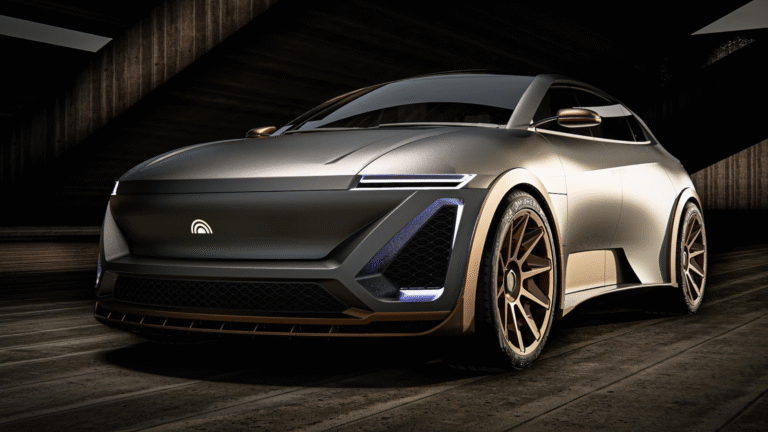The electric vehicle (EV) revolution isn’t just changing what powers our cars—it’s transforming how they look, how they function, and how we interact with them. Freed from the traditional design constraints of internal combustion engines, automakers are reimagining the car from the ground up. From sleeker silhouettes to reconfigurable interiors, EVs are leading the charge into an entirely new era of automotive design.
Let’s explore how the electric drivetrain is reshaping the future of car design.
Table of Contents
- The Architecture Shift: No Engine, New Possibilities
- The “Skateboard” Platform and Flat Floors
- Exterior Styling: Sleek, Slippery, and Efficient
- Interior Innovation: Space, Screens, and Sustainability
- Aerodynamics Take Centre Stage
- Lighting and Grilles: Functional Meets Futuristic
- EV-Specific Design in Australia: Local Considerations
- FAQs
- Conclusion
1. The Architecture Shift: No Engine, New Possibilities
Traditional cars are designed around a bulky engine, fuel tank, driveshaft, and transmission. EVs ditch most of that hardware. Without a front-mounted engine, designers gain freedom to:
- Shorten or eliminate the front bonnet
- Expand the cabin space forward
- Flatten the floor for better legroom and storage
- Use a “frunk” (front trunk) for extra storage
This opens up entirely new vehicle proportions and packaging strategies.
2. The “Skateboard” Platform and Flat Floors
Most modern EVs are built on a skateboard-like chassis that houses the battery pack, motors, and essential components in a single flat platform. This allows:
- A lower centre of gravity
- Improved weight distribution
- More interior space (especially for backseat passengers)
- Flexible use across sedans, SUVs, utes, and even vans
It also helps manufacturers streamline production across different models.
3. Exterior Styling: Sleek, Slippery, and Efficient
EVs prioritise aerodynamic efficiency to maximise range, leading to smoother, more sculpted body shapes. Design features often include:
- Flush door handles
- Slim wing mirrors or camera pods
- Fastback rooflines
- Minimal grilles or completely sealed front ends
These aren’t just futuristic for show—they cut drag and boost range.
4. Interior Innovation: Space, Screens, and Sustainability
EV interiors are being reimagined with an emphasis on spaciousness, digital interfaces, and eco-conscious materials.
Key trends include:
- Larger infotainment screens and fewer physical buttons
- Open cabin designs with lounge-like seating
- Recycled and vegan materials replacing leather and plastic
- Voice and gesture controls integrated with AI systems
Some EVs even feature swivelling seats, movable centre consoles, and built-in desks—blurring the line between car and workspace.
5. Aerodynamics Take Centre Stage
Because energy efficiency is everything in an EV, designers are obsessing over drag coefficients. Every design decision—from wheel design to underbody panels—is optimised for airflow.
Standouts include:
- Tesla Model S (Cd: 0.208)
- Hyundai Ioniq 6 (Cd: 0.21)
- Mercedes EQS (Cd: 0.20, one of the lowest in production)
Expect even mainstream EVs to tout aero numbers in future ads.
6. Lighting and Grilles: Functional Meets Futuristic
EVs don’t need traditional grilles for engine cooling. This frees up the front end for:
- Seamless LED lighting designs
- Illuminated logos
- Dynamic light animations for approach/departure
- Simplified, clean front fascias
Lighting now acts as a brand signature—think of Polestar’s “Thor’s Hammer” headlights or the VW ID series’ full-width light bars.
7. EV-Specific Design in Australia: Local Considerations
While global EV design trends dominate, Australia has some unique considerations:
- High heat means thermal management systems must be robust
- Larger vehicles like SUVs and utes are more popular here, so EVs need to balance form with function
- Rural EV drivers may require additional ground clearance and cargo space
- Off-road-capable EVs are gaining traction, blending rugged aesthetics with EV innovation
Manufacturers are increasingly tuning designs for Aussie tastes—like the Ford F-150 Lightning or BYD ute concepts.
8. FAQs
Q: Are EVs more expensive to design than petrol cars?
A: Initially, yes—but over time, standardised EV platforms and fewer mechanical components reduce complexity and cost.
Q: Will all future cars look the same due to aerodynamics?
A: Not necessarily. While many EVs adopt similar shapes for efficiency, creative use of lighting, materials, and proportions still allows for visual variety.
Q: Do EVs have more interior space than similar-sized petrol cars?
A: Yes—without engines or gearboxes, cabins can be larger and more flexible.
9. Conclusion
EVs are more than a new powertrain—they’re an opportunity to rethink the car from first principles. By breaking free from old design constraints, they’re ushering in vehicles that are smarter, more efficient, and more adaptable to modern life.
Whether it’s a minimalist dashboard, a roomier cabin, or a futuristic light show, EVs are driving car design into the future.
Discover how EVs are reshaping car design—inside and out. From flat floors to sleek aerodynamics, see why electric vehicles are more than just battery-powered.
